
Artifacts of nineteenth-century daily life find new homes in the twenty-first century
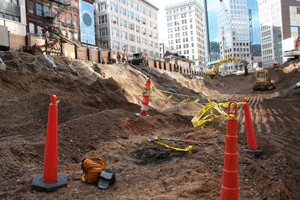
(Courtesy Christine Davis Consultants)
The wide-angle view from Mount Washington, most prominent among the neighborhood hills of Pittsburgh, reveals a lot of details about this city and its proud past and bright future. So does the close-up view from PNC Park, if you overlook the recent fortunes of its primary tenant, the Pirates, a perennial cellar-dweller of Major League Baseball's National League. I watch Pirates right fielder Matt Diaz lean back in the batter's box, smartly smack a single, and scurry to first base. "I took dirt from that side of the infield—hauled it in big buckets on my shoulders," recalls Curtis Biondich, a lifelong Pittsburgher who has accompanied me to the game. "The outfield grass was already in," he continues, "and they were nearly ready to open."
When construction on PNC Park began in the late 1990s, local archaeological firm Christine Davis Consultants, of which Biondich is the principal investigator, conducted an investigation of the site. Much of what Biondich, Davis herself, and their team found, working as quickly as they could over seven deep-winter weeks, now sits on permanent exhibit at PNC Park. Significant artifacts relating primarily to nineteenth-century city life and events on the banks of the Allegheny River tell long-forgotten stories and confirm local lore. The infield dirt that Biondich dug up sat atop 15 layers of earth—the earliest being remnants from prehistoric wetlands. "The water table is much higher here now, so we cannot excavate a lot of stuff," explains Davis. What they could get to, however, combined with more recent excavations at two other nearby sites, injects long-buried information into Pittsburgh's historical narrative. Exhibiting the objects in a baseball stadium is nontraditional, for sure, but preservationists, planners, and developers agree with Davis' belief that "showing history in a different way helps while we are changing our environment today."
In 1907 Pittsburgh became the eighth largest city in the U.S. when it absorbed Allegheny City, now known as the "North Side" neighborhood. Seventy-five years prior to the merger, in 1832, floodwaters reached the second floor of the finest house on the highest point on the Allegheny River. The home was owned by General William J. Robinson, Allegheny City's first mayor. Outbuildings collapsed, dumping household goods into what was then the backyard of his estate (now just inside PNC Park's left-field entrance). More than 160 years later, Davis and Biondich would find many of Robinson's possessions under an oak door with iron and leather hinges buried whole below 15 feet of earth. The door was about five feet tall, two and a half feet wide, and an inch thick. It was painted blue and might have been a kitchen door. "We had to slowly excavate that door—there were other artifacts around it," Biondich says, adding that, because it had not been exposed to air for so long, they had to conserve it immediately. Until he could fashion a makeshift tank from plywood to immerse it in a polyethylene glycol solution, Biondich kept the door damp by spraying it with a mixture of water and alcohol, and he checked it every few days for mold.
General Robinson left his mark on Pittsburgh by naming the so-called "Mexican War Streets," which are now part of a historic district within the North Side. Streets in the area bear the names of the war's generals, such as future U.S. President Zachary Taylor and soon-to-be Confederate General Stonewall Jackson, and of its battles, such as Monterey and Palo Alto. Beneath the door, Davis' team found plenty of evidence that Robinson had actually cultivated his fascination with Mexican and Spanish culture over a lifetime. "We found a Staffordshire plate, part of a set of 21, that told the whole story of Don Quixote, copied from paintings," she says. Other pieces in the collection of blue-on-white English porcelain also depicted Spanish-themed scenes, such as a landscape of Andalusia in southern Spain. "I'd never found an entire collection in blue—or all in any one color," she says, adding that the Robinsons owned pieces of Chinese Canton porcelain that also fit the motif.
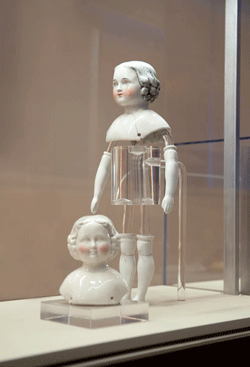
Yeager's, Pittsburgh's first department store, sold hand-painted Kestner porcelain dolls from Germany, among other children's toys, to the city's emerging middle class.
(Courtesy Fairmont Pittsburgh)
"Finding the preserved backyard of a famous individual may be unprecedented in Pittsburgh archaeology," Davis remarks. After her excavations, she tracked down Lela Burgwin, the widow of one of Robinson's descendants. "I did all this digging and learned so much about Robinson and his wife, Mary Parker Robinson," Davis recalls. "And from under her bed, Lela pulled out their portraits." Copies of those paintings, which date to 1815, hang in the PNC Park exhibit alongside the kitchenware and tableware the couple once used.
Pittsburgh had long forgotten or ignored much of the evidence of its own quotidian history and day-to-day middle class domesticity, literally burying and paving it over. The rapid growth of iron and steel manufacturing and dozens of attendant industries and businesses made it, by the late 1800s, the center of the industrial world. Pittsburgh became what English writer Anthony Trollope described as "without exception... the blackest place I ever saw." Railroad tracks lined every waterfront. People were sent in the other direction, scampering up the city's hills to make their homes, neighborhood by isolated neighborhood. "River's edge was the most palpable dump site for a lot of the city's history," says Rob Stephany, executive director of the Urban Redevelopment Authority of Pittsburgh, which has a mission to undo the present-day and persistent undervaluation of riverfronts and to reconnect the city's neighborhoods with its famous three rivers. (The Allegheny and Monongahela rivers combine in downtown Pittsburgh to form the Ohio.) At the confluence of the waterways, even footprints of early forts built in the 1750s, before the American Revolution—Fort Duquesne, which was later destroyed and replaced by nearby Fort Pitt—were hidden for many decades, overwhelmed by a vast army of factories and trains, belching and blasting fire and smoke nonstop. "Hell with the lid taken off," as James Parton famously called it in an 1868 issue of The Atlantic Monthly, an image that stuck and historically overshadowed nearly all else.
Davis did her first urban excavation in 1982 at PPG Place, a complex of six reflective-glass-facade buildings topped with spires, adjacent to Market Square just east of where the two forts once sat. She figured she would turn up evidence of the contributions of hardworking innovative industrialists such as Carnegie, Frick, Westinghouse, or Mellon, who made some of the world's greatest fortunes in Pittsburgh. (Their largesse still benefits the city and the world through libraries, art museums, parks, schools, endowments, and more.) Recovered artifacts, she thought, might also illustrate the great influx of immigrants from Germany, Ireland, Italy, Poland, and elsewhere, mostly unskilled non-English speakers, who crowded in by the thousands to do the filthy, demanding physical labor and formed a large lower middle class. Their legacy lives on in place names (Polish Hill), in foods (pierogis, fish suppers on Fridays, Primanti sandwiches), and especially in the way that families here stay close and often reside in the same neighborhoods for generations.
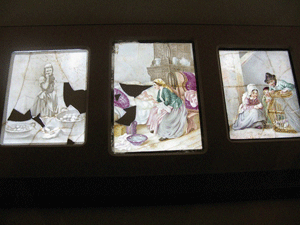
These lithophanes, which once decorated the windows of Knox Botanical and Seed Store, are now on permanent display in the lobby of the Fairmont Pittsburgh.
(Courtesy Christine Davis Consultants)
The PPG dig, however, offered numerous surprises. Davis discovered evidence that as the expanding population fled a dirty, crowded downtown, they left behind the trappings of middle-class families. Davis came upon these artifacts—"tons of yellow ceramics, for example"—in deep wells. "Some of these wells, which would have been for household water or privies, were 40 feet below our street surface," she explains. "A well could be three to five feet around—a big dangerous hole in the backyard—so they would commonly fill it in with discards." Discards that more than a hundred years later tell the story of a lost era of the city.
Construction crews in the very earliest stages of building Three PNC Plaza eventually came upon ten wells and Davis' crew got the call to investigate. What she found were over 26,000 artifacts dating to between 1840 and 1876. These relics combine to create a picture of a downtown Pittsburgh much different from what exists now at the corner of Fifth Avenue and Market Street. Fancy tortoiseshell combs, ladies' shoes, hand-painted porcelain Kestner dolls (imported from Germany for local children), and caches of whiskey and wine bottles remain at the site of Yeager's, Pittsburgh's first department store. In another well, china with exotic scenes and American Fancy dishes with bright naturalist designs tell the story of Ferdinand Stark's German boarding house, which lodged young immigrant engineers, a coppersmith, and a printer.
Much of the long-buried nineteenth-century domestic goods now reside in the Fairmont Pittsburgh, an art-meets-industry–styled hotel on the corner of Fifth and Market. The decision to incorporate them into the building came out of a 15-minute meeting that Davis had scheduled with PNC CEO and Chairman James Rohr. But the show-and-tell session stretched on for more than an hour. "When I lit up the lithophanes [thin, translucent porcelain panes that appear three-dimensional when backlit, which had been window decorations in Knox Botanical and Seed Store], he was sure this was history that should be shared." Fairmont Pittsburgh General Manager Len Czarnecki decided to dedicate each of the hotel's 10 guest room floors to one of the 10 wells. All the suites have artifacts on display and are named for the nineteenth-century businesses to which they belonged.
Taken together, the content of the wells tells the stories of the daily commerce of a rising middle class that wanted to possess and consume fine things. But there is also strong evidence of varying aesthetic preferences. Take the instance of an Irish boarding house, located on the same block as a German boarding house. Finds associated with the German lodgers included ceramics, pipes, and other household artifacts manufactured in Germany, whereas the well near the Irish inn contained mostly American-made items. "Germans tended to bring stuff with them," Davis concludes. "And the Irish tended to buy stuff in America."
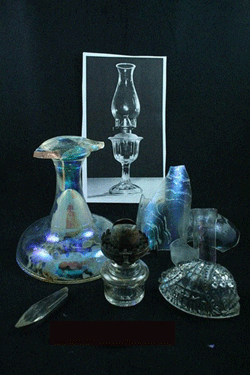
Archaeologists found much evidence of middle-class life, such as these kerosene lamps, along with porcelain tableware and a dollhouse tea set.
(Courtesy Curtis Biondich)
Industrialization penetrated every street corner in the city, every household. After the Civil War, as shop buildings made way for progress, General Robinson from Allegheny City bought the German boarding house and tore it down in order to build offices for his Ohio and Pittsburgh Railroad.
With business booming and population swelling toward the end of the 1800s, Pittsburgh had a housing crisis. "People would live anywhere," says Davis, as we stop in to see a small exhibit at the Carnegie Science Center. She points out a copy of a postcard with a picture of the North Side neighborhood. In it, Monument Hill rises behind behemoth smoke-belching factories with a tattered navy of small rivercraft—makeshift houseboats—tied up all along the Allegheny. "There was a preconceived notion that houses in the midst of all this, especially next to a tar factory, would have been a slum," she says. Twenty-first-century progress—construction of Allegheny Station for the North Shore Connector (an extension of the light rail system by the Port Authority of Allegheny County) set to open in 2012—led Davis' team to investigate the site. And, once again, the archaeologists uncovered an informative trove of upper-middle-class lifestyle possessions from the wells, privies, and large backyards (containing both gardens and buried cache boxes) of five row houses that stood until 1932.
From nearly 18,000 artifacts, more than 45,000 ethnobotanical specimens (seeds, nuts, and other plant remains), and deep dives into city directories and census records, Davis was able to identify 350 individuals who lived in these houses over a 65-year period. The great find at this particular site, however, was toys. "Evidence of children is very difficult to find in an archaeological context," Davis says. After all, they don't really own things such as pots or jewelry. Here, though, is a collection that's remarkable both for its unprecedented size and for what it tells us about the finances of the children's parents. "Tiny German-made bubble pipes, a miniature porcelain tea set for a dollhouse, a child's plate with a raised alphabet rim to teach reading, a small mug with a fairytale scene," Davis says, cataloging the finds. "You wouldn't have bought these things if you were living paycheck to paycheck." In addition to the toys, the archaeologists found severely worn scrub brushes, toothbrushes, children's lice combs, and many, many medicine bottles. In the very crucible of this filthiest of cities, parents had an obvious concern with hygiene and spared little expense to make sure their children were clean and healthy.
Other items recovered from the town houses speak to their residents being decidedly middle class. "We have a kerosene table lamp—an expensive piece—and decorative ceramics with no wear, indicating they just sat in a cupboard," says Davis. "For instance, a Brown Betty tea pot is what a lady would have held up to show off her contrasting unblemished white hands." Wear patterns on these pieces tell Davis that these houses, unlike those thrown up quickly near mills for low-rung workers, had one particular all-important middle-class status symbol: a parlor. From the evidence she assembled, Davis was even able to make an educated guess about the profession of one of the row house dwellers. Her team found several needles as well as dozens of miniature German-made porcelain doll arms, legs, and heads that would have been sewn to a fabric torso. "I wondered if this wasn't a doll-maker's shop," she explains. "The woman was a widow, and this would have been one of the few ways she could have made money."
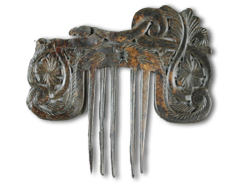
Yeager's also sold Pittsburgh's ladies ornate, tortoiseshell combs, as well as shoes and wine.
(Courtesy Christine Davis Consultants)
Popular among the local lore of the Steel City is the legend of Pittsburgh's fourth, underground river. I even hear about the supposed lost waterway from a bus driver who turns into an impromptu tour guide as he drives his route to Homestead, a historic steel mill site that today is the museum and headquarters of Rivers of Steel, a National Heritage area. Turns out the river is not simply apocryphal. The Pennsylvania Canal, completed in 1832, greatly eased transport between the western and eastern sides of the state until it was abandoned and filled in when railroads superseded it.
Davis was on the lookout for the canal during the initial survey of the PNC Park site. She searched archival maps and combined her findings with "hugely expensive" camera work from another consultant to pinpoint four underwater locks—used to raise and lower shipping vessels as they travel over a waterway with different levels. "At the PNC Park ceremonial groundbreaking the first shovel came right down on Canal Lock No. 1," she recalls. "That was like finding the Holy Grail," says August Carlino, president and CEO of Rivers of Steel. Davis had proved the legend of Pittsburgh's fourth river to be true, but the various technological surveys showed the canal wasn't worth exploring. "All the lock doors had been removed, and the canal had been used as a sewer, so what was left was not anything that we could excavate," Davis explains. Alas, all the canal remnants themselves had to be filled in with concrete and reburied.
That April night at the ballgame, I think about that lock being directly under home plate, each of the six times a Milwaukee Brewer scores. The present-day Pirates may be hapless, but their history—including the team's participation in the first modern World Series in 1903, which was played at Exposition Stadium a mere few hundred yards away—is extraordinary. Beyond the field lies a city—once decidedly part of the Rust Belt—now dotted with green-certified buildings. "Topography saved us," says Rob Stephany. "Those hills that kept neighborhoods separated also kept them intact." He adds that the city has always had a diverse economy and that is borne out by the archaeological record. "Pittsburgh," he adds, "has a great history." And as the city moves on, it won't lose the connection to its rich past.
Margaret Shakespeare is a writer who lives in New York City and on the North Fork of Long Island.
Advertisement

Advertisement







